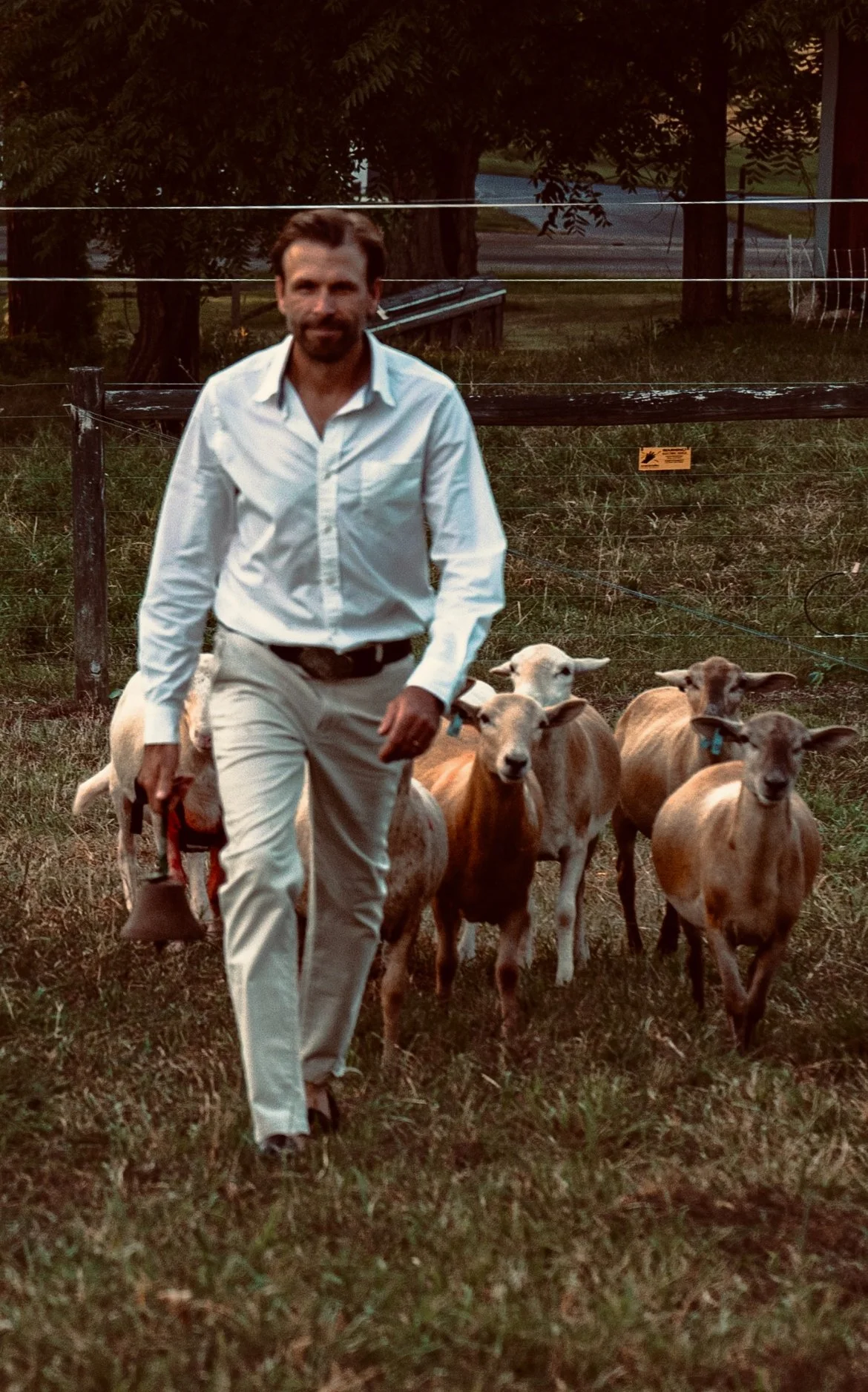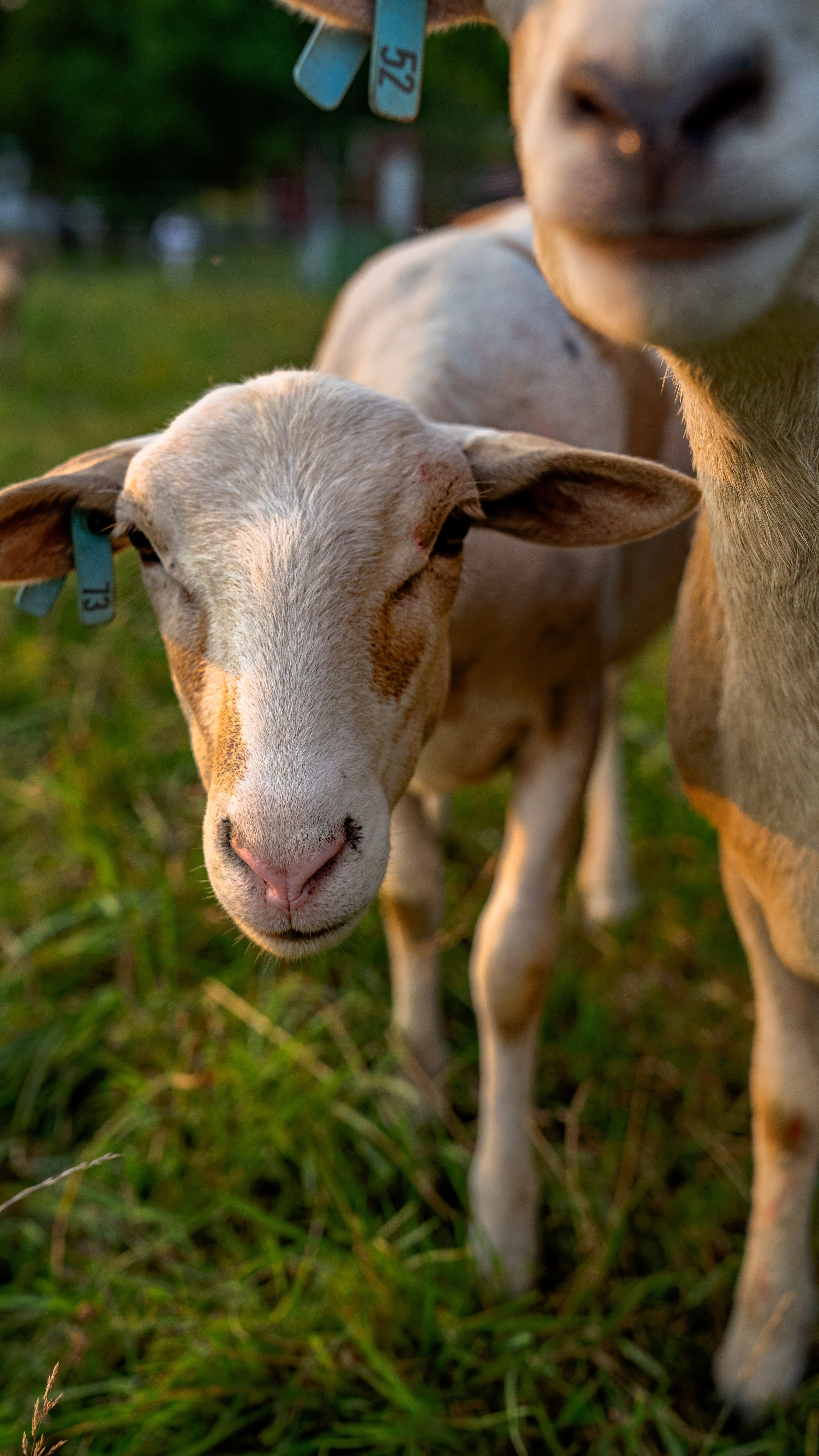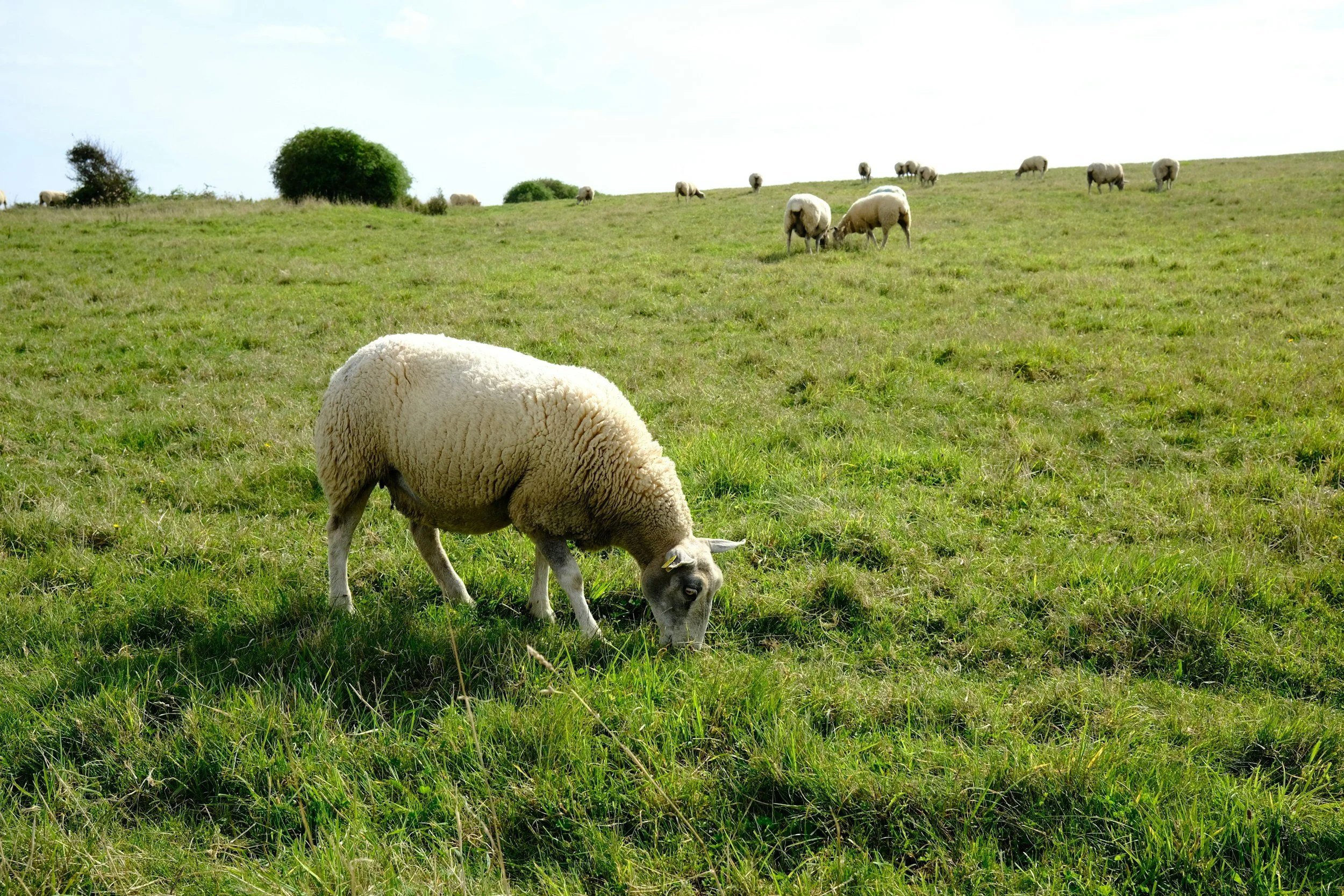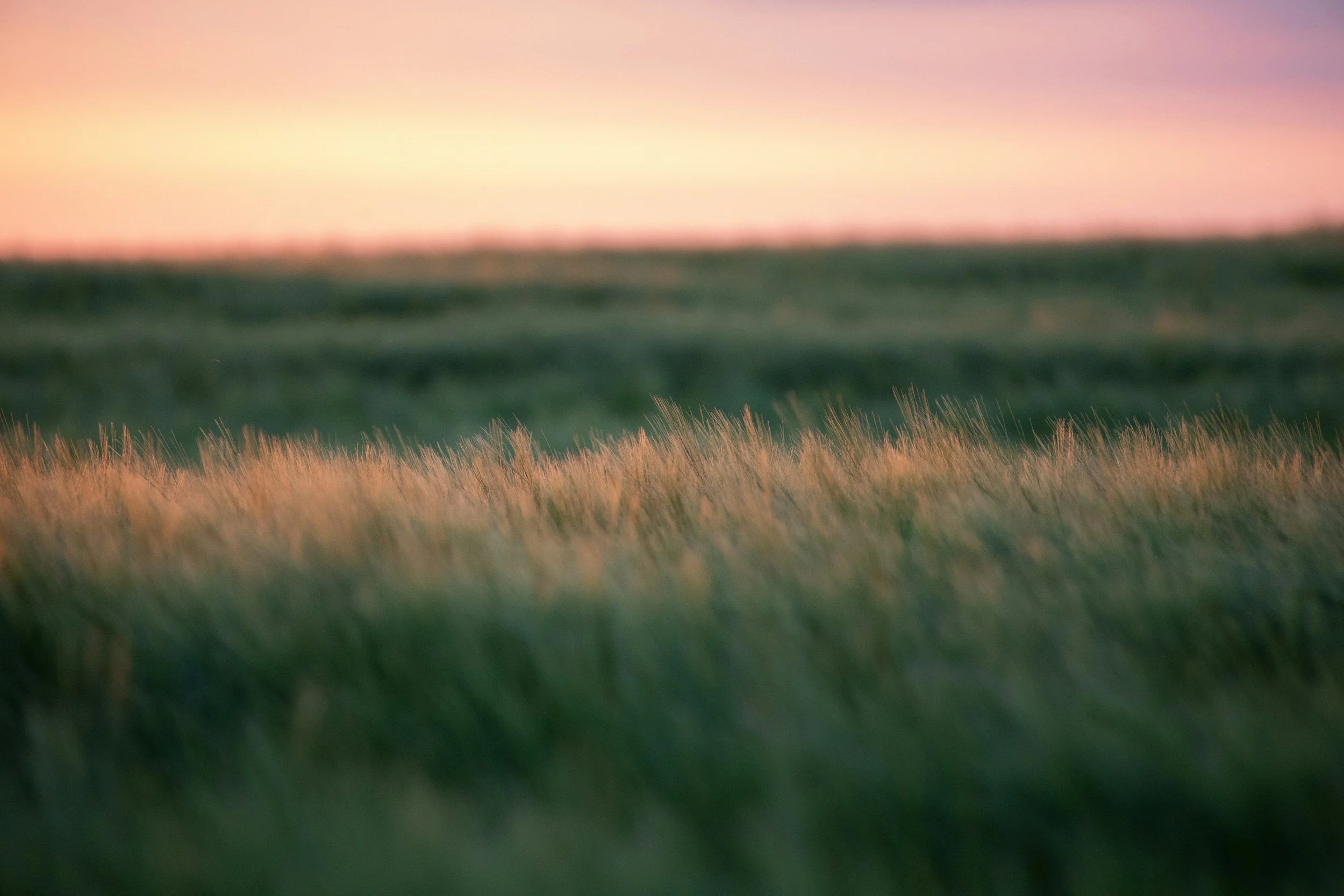Lake Effect Lamb
At Ridgemeade, welfare and quality aren’t a paid certification—they’re part of a covenant and a legacy where every life is in rhythm.
Guided early on by John & Sukey Jamison of Jamison Lamb Farm—whose approach to stewardship and flavor set the benchmark for the craft—we carry forward the ideals and methods he championed while shaping them to the particulars of this ridge and its climate.
Along the great, Southern Lake Erie ridge, a unique maritime microclimate shapes every blade of grass and, in turn, every note of flavor. The lake’s thermal mass keeps our pastures green for weeks longer than inland farms, allowing our flock to graze deep into November on cool-season grasses and herbs rich in natural sugars and terpenes. Beneath our pastures lie Laurentide glacial soils—mineral-dense with calcium and magnesium—much like those that sustain the region’s renowned vineyards. These minerals, and the herbs and shrubs that thrive in this moderated climate, impart the clean yet complex character that chefs once crossed oceans to find in France and New Zealand. Even winter serves the flavor: heavy lake-effect snows insulate roots, recharge springs, and ready the ground for spring’s renewal.
This isn’t simply grass-fed lamb; it’s terroir-driven—born of water, wind, and natural farming stewardship along the southern ridge of Lake Erie’s ancient coastline.
This is “Lake Effect Lamb.”
For ongoing reflections from our fields and kitchens, visit Field Notes →
The Ecology
The land beneath our flock is not a backdrop — it’s a living partner.
Our pastures form a mosaic of cool-season grasses, clovers, chicory, plantain, and native bluestem, chosen for deep roots and mineral draw. Each move of the sheep begins a cycle: grazing trims the canopy, hooves press seed and litter into soil, and rest periods allow regrowth. In time, this rhythm restores fertility without fertilizer.
Because we farm within the Lake Erie thermal belt, our growing season stretches weeks longer than inland ground. That extended window allows plants to mature slowly, developing the essential oils and sugars that nourish both sheep and soil life. Earthworms, dung beetles, and fungi thrive here, transforming manure into humus and keeping carbon where it belongs — in the ground.
Around the pastures, we’ve planted shelterbelts of willow, dogwood, and elder to protect against wind and invite pollinators. Hawks nest in the pines, swallows patrol for insects, and native wildflowers mark each paddock rotation with color. Water flows clean through these meadows, filtered by roots and renewed by rain.
Our aim is not to improve upon nature, but to cooperate with it — to build an ecology that sustains itself through harmony, not control. The result is healthier land, resilient animals, and a flavor that tells the truth about where it comes from.
View our evolving Pasture Biodiversity List→
The Flock
Our flock lives by the rhythm of the land—never confined, never hurried.
Each day they move to new pasture, grazing on grasses, clovers, and herbs that mirror the complexity of our soil. They drink from spring-fed water, rest under open sky, and grow at the pace nature intends.
We keep our numbers small enough to know every ewe by sight. Lambs stay with their mothers until natural weaning, learning to graze as a family. We use no feedlots, no grain, and no routine antibiotics—only clean forage, mineral salt, and attentive care. When intervention is needed, it’s swift, kind, and purposeful.
Years of quiet handling and intensive genetic selection have shaped our flock’s calm temperament. Our ewes are excellent mothers, requiring no intervention, and our lambs thrive in our diverse, native pastures and woodlands. The sheep trust the bell and the bucket and the shepherd; they follow willingly because they are never forced and because it always leads to greener pastures. That calm carries through every stage of their lives, and the farm, yielding meat that is tender not only because of fine forage, but because it comes from animals that have known peace.
For more on the history of the property visit History →
Our Covenant
Stewardship, for us, begins in gratitude.
Eventually, all life nourishes another - this is the sacred bond, the sacred exchange that is we are all a part of. That exchange must be met with reverence, not efficiency.
Every decision on this ridge — when to move a flock, when to rest a field, when to harvest a lamb — is guided by the question: Does this increase peace? Peace among animals, between farmer and land, and within the small circle of creation that sustains us all.
Our harvests are intentional and unhurried. Lambs are handled gently from birth in the field to processing, and their end is swift, quiet, and free from fear. Each season’s first harvest begins with a moment of silence in the pasture — a ritual of thanks for the lives entrusted to us and for the unseen generosity of the earth itself.
Nothing here is wasted. Hides are tanned, bones become broth, and fat renders into soap and light. Even what returns to the soil does so with purpose, completing the cycle that began in spring’s green flush. We see this not as production but as stewardship, as participation — a humble role in the endless renewal of life.
This is our covenant:
to farm as though every creature
and every handful of soil were sacred,
because they are.For a little more backstory visit Family →
The Ridgemeade Standard
Our work begins with story but ends with standards. The Ridgemeade Standard sets the measurable practices that sustain our promise: peace for the flock, renewal for the land, and integrity in every choice we make. Each line of this covenant is lived daily on the ridge.
Animal Welfare
Calm handling. No dogs, prods, or crowding — just bell, bucket, and voice.
Pasture every day. No confinement or feedlot periods; animals graze under open sky year-round with weather-appropriate shelter.
Clean water. Continuous access to well and spring-fed sources tested for quality.
Humane veterinary care. Prompt, compassionate treatment when illness occurs; never prophylactic antibiotics or growth stimulants.
Mother-led rearing. Ewes nurse lambs naturally until natural weaning.
Ecological Health
No synthetic fertilizer or herbicide. Soil fertility built from compost, and adaptive grazing animal impact.
60-90+day rest between grazings. Adaptive, rotational paddocks protect root vigor and carbon retention.
Diverse forage. Over 100 species of grasses, legumes, forbs, and woody species support pollinators and wildlife.
Soil & pollinator monitoring. Annual tests track organic matter, infiltration, and species diversity.
Water stewardship. Riparian buffers and contour plantings prevent runoff and erosion.
Ethical Stewardship
Gratitude. Each harvest begins with silence and thanksgiving for the lives that sustain us.
Waste-nothing ethic. Hides tanned, bones rendered, fat turned to soap; all by-products valued.
Education & transparency. Open-farm tours, chef visits, and mentorship for the next generation of natural farmers.
Continuity of care. Every life and landscape tended as if it were our own — because it is.
Underlying Principles
The Holsitic Management Framework by Alan Savory, tied together with Permaculture Principles, guides everything we do here at Ridgemeade. Our standards are guided by eight principles as outlined below.
TRANSPARENCY
We hold an open-farm-gate policy. Anyone is welcome to visit the farm simply by making an appointment. We harbor no trade secrets and nothing is hidden behind the curtain.
PASTURE-BASED
Our livestock is never fed grain and lives on fresh pasture grass all day every day. We move them daily and/or weekly to fresh growth according to our Holistic Management Plan and the ever changing patterns of nature. This heals the landscape, sequesters carbon, and creates unparalleled nutritional and flavor superiority. Our lambs are happy, healthy, and drug free.
ANIMAL NATURE IS NURTURED
Plants and animals are provided a habitat that allows them to express their physiological distinctiveness - what one of our mentors Joel Salatin calls respecting and honoring the “pigness of the pig” even if it means less convenience for us.
COMMUNITY
We believe in the Integrity Food movement. We must all seek clean, ethically cultivated, transparently produced foods from closer to home while trying to eat more seasonally to guarantee freshness and respect for the earth’s capabilities.
BIOMIMICRY
By mimicking natural patterns instead of flouting them, we avoid degradation of the land, disease, and suppression of the natural ecological systems on our land. This helps ensure moral and ethical boundaries and symbiotic practices within our agricultural activities that not only restore local ecosystems but also foster and support native wildlife rather than
eliminate it.
CARBON SEQUESTRATION
We’re actually in the business of farming grass… which means we’re in the business of farming earthworms, nematodes, bacteria and fungi in the soil. Stimulating soil biota is our first priority. Soil health creates healthy food and builds true, generational stability. We believe the basis for life and dynamically sustainable ecology is soil health.
8 FORMS OF CAPITAL
Our modern world seems hell-bent on a financial bottom line that pleases shareholders at any cost. A slight improvement came with the concept of the triple bottom line, taking into equal consideration the Financial, Social, and Environmental impacts of human activity. For us, that isn’t good enough. Instead, we are 100% dedicated to constant monitoring and enhancement of the 8 Forms of Capital as brilliantly described by the concept creator - Ethan Roland. These include Living, Cultural, Experiential, Intellectual, Spiritual, Social, Material, and finally, Financial capital. We encourage you to learn more HERE.






